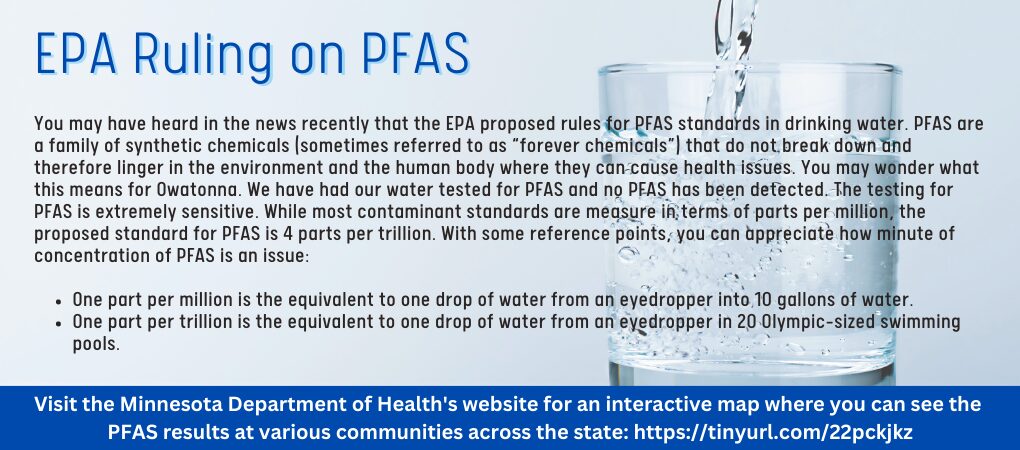Lead in Drinking Water
Lead is a poisonous metal that can cause long-term health and behavioral problems. The main way to come in contact with lead in Minnesota is through lead-based paint in homes built before 1978. There are also many other ways to come in contact with lead, including through drinking water.
Coming in contact with lead can cause serious health problems for everyone. There is no safe level of lead. Babies, children under six years, and pregnant women are at the highest risk. Drinking, breathing, eating or touching food, water and other materials that contain lead can damage the brain, kidneys, and nervous system. In children, lead can also slow development or cause learning, behavior, and hearing problems.
Exposure to lead in drinking water can cause serious health effects in all age groups. Infants and children can have decreases in IQ and attention span. Lead exposure can lead to new learning and behavior problems or exacerbate existing learning and behavior problems. The children of women who are exposed to lead before or during pregnancy can have increased risk of these adverse health effects. Adults can have increased risks of heart disease, high blood pressure, kidney, or nervous system problems.
All community water systems (including Owatonna Public Utilities) follow the U.S. Environmental Protection Agency (EPA) standards for testing for lead and copper. We also follow EPA standards to ensure water does not easily dissolve lead and copper while moving through pipes. You can find the levels of lead and copper in Owatonna’s water system detected by looking at your Consumer Confidence Report (CCR), also known as an annual drinking water quality report.
You may be in contact with lead through paint, water, dust, soil, food, hobbies, or your job. Visit Common Sources of Lead to learn how to reduce your contact with lead from sources other than your drinking water.
Lead can get in your drinking water as it passes through the plumbing in your house or when it sits in lead pipes for a while. Read below to learn how to protect yourself from lead in your drinking water.
- Let the water run for at least 1 minute before using it for drinking or cooking if the water has not been turned on in over six hours. If you have a lead service line connecting your home to city water, you may need to let the water run 3 – 5 minutes.
- Use cold water for drinking, making food, and making baby formula. Hot water releases more lead from pipes than cold water.
- Test your water. In most cases, letting the water run and using cold water for drinking and cooking should keep lead levels low in your drinking water. If you are still concerned about lead, arrange with a laboratory to test your tap water. Testing your water is important if young children or pregnant women drink your tap water. All testing should be done through an accredited laboratory. Contact a Minnesota Department of Health accredited laboratory to purchase a sample container and instructions on how to submit a sample. You can also contact OPU to discuss water testing options.
- Get the lead out. Find out if you have a lead service line connecting your home to city water by looking up your address on the Minnesota Department of Health and University of Minnesota interactive map. If you do have a lead service line, make plans to get it replaced by contacting OPU at opuwater@owatonnautilities.com. If your home has plumbing fixtures made before 1986, you may want to consider replacing them with newer, lead-free fixtures if testing shows lead is present and is not reduced by letting the water run.
- Treat your water. If you cannot find the source of lead and letting the water run does not reduce lead levels, you may need to consider a water treatment option such as a certified filter for lead removal. See Home Water Treatment for more information.
If you have a private well
Lead is not usually found in well water. Lead may enter your drinking water as it travels from your well through your plumbing system. Wells, pipes, solder, and fixtures built before 1995 may have parts that have lead in them. Visit Lead in Well Water Systems or OPU’s Wellhead Protection & Private Wells page to learn more. Make sure you use cold water and let it run before using it for drinking and cooking. You are responsible for keeping your well water safe and testing it as needed.
Lead occurs naturally and has been used in many products worldwide, going back to at least the Roman Empire. As lead has been studied over the years, we keep identifying additional ways that it is toxic. Levels that were once considered safe are now dealt with as a medical emergency. The EPA continues to research lead to decide if more actions are needed. A law passed in 1986 restricts how much lead can be used in plumbing parts. In 2014, the 1986 law was made even stricter. Some plumbing parts still have minimal amounts of lead in them. Other parts are now made of materials other than lead; one of those materials is copper. Like lead, copper can also dissolve into water, and too much copper can be harmful to you. Read more about Copper in Drinking Water.
The EPA has an action level of 15 parts of lead per billion parts of water (ppb) for public water systems. Therefore, a public water system must take action to reduce the amount of lead in the water if more than 10 percent of the water samples have lead levels over 15 ppb. This is an action level; there is no safe level of lead in the water.
The number of people with reported high blood lead levels in Minnesota has been decreasing since at least the 1990s. The most common way for Minnesotans to come in contact with lead is through lead-based paint found in homes built before 1978.
In 2021, only 4 out of 1,441 tested public water systems in Minnesota went over EPA’s lead action level. These systems are finding ways to correct the issue. There can still be lead in drinking water in Minnesota homes depending on when homes were built. Homes built before 1940 may have lead service lines that connect them to public water. In addition, plumbing parts made before 1986 may contain lead.
Learn more about lead levels in Minnesota.
Lead programs at MDH work with state and local partners to find and eliminate lead hazards in homes, retail goods, and other areas. MDH also regulates public water systems by:
- Approving public water systems’ treatment plans
- Enforcing the Safe Drinking Water Act (SDWA) which has a specific part addressing lead and copper. See Background on Drinking Water Standards in the Safe Drinking Water Act (SDWA).
- Testing public water supplies
MDH keeps track of blood lead levels in Minnesota. MDH also makes sure children and pregnant women with high blood lead levels get help to reduce lead risks. Through outreach, MDH helps people learn about the risk of lead and how to reduce contact with lead. MDH provides guidance for:
- Lead in Well Water Systems
- Reducing Children’s Exposure to Lead in Drinking Water (PDF)
- Lead in Drinking Water in Child Care Settings
- Drinking Water in Schools, Child Care and Head Start Programs
Learn more about lead at Lead Poisoning Prevention.
Many local, state, and national agencies work on lead issues around the country. The web pages below are some key sources for more lead information:
Copper in Drinking Water
Copper is a metal that occurs naturally and is used to make many products, including parts for plumbing systems. Copper can get into your drinking water as the water passes through your household plumbing system. Your body needs some copper to stay healthy, but too much is harmful.
Eating or drinking copper does not usually cause illness in most healthy people. Most people’s bodies process copper effectively.
However, it is possible that eating or drinking too much copper can cause headaches, vomiting, diarrhea, stomach cramps, nausea, liver damage, and kidney disease. High levels of copper may damage red blood cells and may also reduce the ability of red blood cells to carry oxygen. Male fertility may be affected by high levels of copper. People with Wilson’s disease and some infants (babies under one year old) are more sensitive to copper. Their bodies are not able to get rid of extra copper easily.
Healthy people usually do not have illness associated with eating or drinking copper because their bodies are able to maintain an appropriate level of copper through normal functioning of body systems. For more information, visit Copper | The Nutrition Source | Harvard T.H. Chan School of Public Health
Drinking water with more than 1,300 micrograms of copper per liter of water (µg/L) * can be a health risk for everyone. Infants and people with Wilson’s disease may need water with an even lower level of copper to stay safe.
Copper can get into your drinking water as it passes through your plumbing system. Over time, plumbing parts with copper in them usually build up a natural coating that prevents copper from being dissolved into the water. Plumbing systems with copper parts less than three years old usually have not had time to build up this protective coating.
Knowing about your home’s plumbing system can help you understand your potential exposure to copper from your drinking water. If you cannot determine what type of material your home is plumbed with, consult a plumber, building inspector, or other qualified person.
You can take the steps below to help keep your drinking water safe:
- Let the water run for at least 30-60 seconds before using it for drinking or cooking if the water has not been turned on in over six hours.
- Use cold water for drinking, making food, and making baby formula. Hot water releases more copper from pipes than cold water.
- Test your water. In most cases, letting the water run and using cold water for drinking and cooking should keep copper levels low in your drinking water. If you are still concerned about copper, arrange with a certified laboratory to test your tap water. Testing your water for copper is important if an infant or someone with Wilson’s disease drinks your tap water. Minnesota Department of Health (MDH) recommends using an accredited laboratory. See Search for Accredited Laboratories. Contact the laboratory to get sample containers and instructions or ask your county environmental or public health services if they provide water testing services.
- If tests show you have levels of copper over 1,300 µg/L in your drinking water after you let the water run 30-60 seconds, you may want to consider home water treatment. See Home Water Treatment.
* 1 microgram per liter (µg/L) = 1 part per billion (ppb)
If you have a private well
Copper is not usually found in the groundwater that feeds your well. Copper may enter your drinking water as it travels through your plumbing system. If your plumbing system has parts made with copper, follow the steps above to help keep your drinking water safe.
If you have a new well connected to your drinking water system, the new well may have different water characteristics than your old well. Be aware that the water from the new well may dissolve copper from your plumbing.
If you are on a public water system
The U.S. Environmental Protection Agency (EPA) has an action level of 1,300 µg/L for public water systems serving places where people live, work, go to school, and receive childcare. These systems have to take actions to reduce the amount of copper in the water if more than 10 percent of the water samples they take from homes and sampling sites served by the system have copper levels over 1,300 µg/L.
You can find the level of copper detected in Owatonna’s water system by reading our Water Quality Report (also known as a Consumer Confidence Report (CCR). Remember that your home may have higher levels of copper in drinking water than the homes tested. Follow the steps above to help keep your drinking water safe.
Very few homes constructed in the last 20 years are plumbed with copper due to the cost. Most newer homes are plumbed with plastic piping (like PEX or PVC) but may still use copper fittings or components.
Older homes are more likely to have copper piping and copper can get into drinking water if the water moving through the plumbing system is corrosive. Corrosive water can dissolve copper in plumbing parts. Pinhole leaks, pitting in your pipes, or blue green stains on plumbing fixtures may be signs that you have corrosive water. If you see signs of corrosive water, Lead in Drinking Water may also be problem. Water with a lot of dissolved copper in it can make drinking water taste or smell bad or give it a blue color.
Some groundwater in Minnesota can be corrosive enough to dissolve copper. Although the pH of groundwater in Minnesota is normally high enough to prevent water from dissolving copper, there are other water qualities that may contribute to corrosion.
Public water systems monitor how corrosive water is to reduce the risk of lead and copper getting into drinking water. Learn more about copper and lead levels in Minnesota public water systems at Drinking Water Protection Annual Reports.
In 1999, the Minnesota Pollution Control Agency found that none of the 954 wells they tested in Minnesota had copper levels over the EPA action level.
MDH regulates public water systems by:
- Approving public water systems’ treatment plans
- Enforcing the Safe Drinking Water Act, which has a specific part addressing lead and copper
- Testing public water systems
MDH also studies the presence and risk of chemicals, such as Copper Sulfate and Chromated Copper Arsenate, that break down into copper and can enter water.
- The Agency for Toxic Substances and Disease Registry provides a Toxicological Profile for Copper.
- A new U.S. Geological Survey Study Shows High Potential for Groundwater to be Corrosive in Half of U.S. States.
PFAS Standards

Consumer Confidence Report (Water Quality)
Consumer Confidence Report (Water Quality Report)
General Water Characteristics
mg/L or ppm: means Milligrams per Liter or Parts per Million
| Description | Results |
|---|---|
| pH | 7.7 units |
| Temperature | 42 degrees |
| Solids, Total Dissolved | 461 mg/L |
| Sulfate | 16 mg/L |
| Chloride | 57.6 mg/L |
| Total Alkalinity | 320 mg/L |
| Specific Conductance | 816.0 umhos/cm |
| Calcium | 74 mg/L |
| Magnesium | 35.0 mg/L |
| Sodium | 13 mg/L |
| Aluminum | <.028 mg/L |
| Iron | .007 mg/L |
| Manganese | .025 mg/L |
| Zinc | .003 mg/L |
| Fluoride | .3 natural mg/L |
| Average Chlorine Free | .04 mg/L |
| Average Chlorine Total | 1.3 mg/L |
| Average Hardness | 17.1 mg/L |
The public water supply for Owatonna is tested regularly for these contaminant groups:
- Coliform Bacteria
- Nitrate
- Nitrite
- Inorganics
- Volatile Organics
- Trihalomethanes
- Synthetic Organics
- Radiochemicals
There are approximately 120 different contaminants tested with these groups.
NOTE: OPU water meets or exceeds all Federal and State water standards.
Water Safety
Water & Electricity – A Deadly Combination
We use electrical appliances and equipment to perform countless chores and activities around the home every day. These items are quite frequently used in a very close proximity to water…more…
Scalding from Excessively Hot Tap Water
According to the U.S. Consumer Product Safety Commission, there are approximately 3,800 burn injuries and 34 deaths caused by excessively hot tap water…more…

